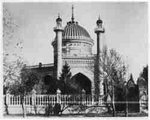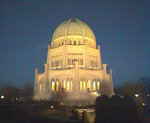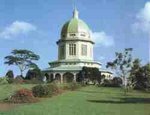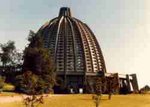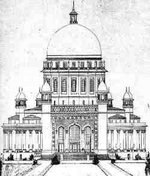|
|
There are currently seven Bahá'í Houses of Worship around the world, although Bahá'í communities own many properties where they plan for Houses of Worship to be constructed as the Bahá'í community grows and develops. Most Bahá'í meetings occur in individuals' homes, local Bahá'í centers, or rented facilities.
| Contents |
Description
The name used in the Bahá'í writings for Houses of Worship is Mashriqu'l-Adhkár (Dawning-place of the Remembrance of God). All Bahá'í temples share certain architectural elements, only two of which are specified by Bahá'í scripture, that they are nine-sided and surmounted by domes. To date all the temples built or planned have a single, undivided room under the dome. In all seven, the seats in the auditorium face the Shrine of Bahá'u'lláh in Acca, Israel.
The seven existing Houses of Worship were built as the regional community could support their construction. They express local design and culture in their selection of materials, landscaping and architecture.
Bahá'í Houses of Worship are open to people of all faiths - or of no particular faith. Services focus solely on the worship of God. There are no collections and no sermons. Only the Word of God is uttered within the Temple, with readings from all the Holy Writings of the earth. The only instrument used is the human voice, and the choir in any Bahá'í House of Worship sings without instrumental accompaniment. No sermons or lectures are permitted inside the House of Worship. As the Bahá'í Faith has no priesthood, ordinary members of the community - men and women, adults and children - read the texts.
There are no collections during the service. Only Bahá'ís are permitted to contribute to the upkeep of the House of Worship.
These buildings are the key element of a complex of facilities such as schools, hospitals, homes for the elderly, and other social and humanitarian institutions to serve the neighborhoods in which they are located.
Bahá'u'lláh said that any work done in a spirit of service is a form of prayer. The educational, humanitarian and scientific institutions to be built around the Temple will allow the Bahá'ís to complete their dedication of the individual to God. To Bahá'ís there is no particular division between the spiritual and practical parts of life. `Abdu'l-Bahá taught that we should walk the spiritual path with practical feet.
Note that the Bahá'í gardens and the Shrine of the Báb in Haifa, Israel are not part of a Mashriqu'l-Adhkár although tourist material generally refer to the Shrine as a Bahá'í temple.
History
Ashkhabad Turkmenistan
The first Bahá'í Temple was completed around 1908 in Ishqábád or Ashkhabad, then ruled by Russia and now the capital of Turkmenistan. Ashkhabad is located in the desert plain of western Turkmenistan near the foothills of the Alborz Mountains. Under the protection and freedom given by the Russian authorities, the number of Bahá'ís there rose to over 1,000 and for the first time anywhere in the world a true Bahá'í community was established, with its own schools, medical facilities, cemetery, etc. Eventually the Bahá'ís in 'Ishqábád decided to build the institution that Bahá'u'lláh has ordained as the spiritual and social heart of the Bahá'í community, the Mashriqu'l-Adhkár.
The Temple itself was surrounded by gardens. At the four corners of the garden were four buildings. A school, a hostel where traveling Bahá'ís were entertained, a small hospital, and a building for groundskeepers. The Bahá'ís lived as much as possible in proximity to the Mashriqu'l-Adhkár. It was the center of the community materially, as well as spiritually.
After the Soviet conquest of Turkmenistan, the Temple was secularized by the Soviets and was used for some time as a museum. It was eventually demolished after severe damage caused by an earthquake rendered the building unsafe.
Existing structures
There are currently seven Bahá'í Houses of Worship.
Wilmette, Illinois USA
The Bahá'í Temple in Wilmette, Illinois, USA was completed in 1953, the Wilmette House of worship is the largest and the oldest surviving Bahá'í Temple. It stands north of Chicago, Illinois on the shores of Lake Michigan. Constructed entirely out of cast concrete its inner and outer lace domes have been awarded numerous design awards and it is a prominent Chicago landmark. The Wilmette temple is unique in that it has a clerestory balcony from which the Temple choir performs. The Wilmette Temple has some, but not all the ancillary functions required to complete a Mashriqu'l-Adhkár.
- Satellite image (http://maps.google.com/maps?ll=42.074387,-87.684081&spn=0.005096,0.007918&t=k&hl=en)
Kampala Uganda
The Mother Temple of Africa is situated on Kikaya Hill on the outskirts of Kampala, Uganda. Its foundation stone was laid in January 1958, and was dedicated on January 13 1961.
Sydney Australia
Bahai_how_sydney2.jpg
The Temple in Sydney, Australia was completed in 1961 of local hardwoods and concrete surmounted by a dome and is capable of accommodating up to six hundred people. It is set high in a natural bushland setting of 380,000 square metres in Ingleside, a northern suburb overlooking the Pacific Ocean. This Temple serves as the Mother Temple of Australasia.
Langenhain Germany
The European House of Worship is located at the foot of the Taunus Mountains in the village of Langenhain (part of the town of Hofheim) approximately 25 km west of Frankfurt am Main, Germany. It was completed in 1964 and is constructed of steel, aluminum and glass. Five hundred and forty diamond-shaped windows give the dome an optical lightness and permit the sunlight to play in it. The outstanding characteristic acoustics of this setting are created by the reverberation within the dome and the resonation of its myriad window ledges. More information here: Baha'i Chants at the European House of Worship (http://www.chants.info).
Panama City Panama
Bahai-how_panama.jpg
The Bahá'í temple in Panama City, Panama completed 1972, serves as the mother temple of Central America. It is perched on a high cliff overlooking the canal, and is constructed of local stone laid in a pattern reminiscent of Native American fabric designs.
Tiapapata Western Samoa
Bahai_how_samoa.jpg
The Bahá'í Temple in Tiapapata, eight km from Apia, Western Samoa was completed in 1984. It is completely open to the island breezes. It was dedicated by King Malietoa Tanumafili II, King of Western Samoa, who is the first reigning monarch who is a Bahá'í. Its 30 meter dome is used for individual prayer, and holy days and weekly devotions.
New Delhi India
The Bahá'í temple in New Delhi, India was completed in 1986. It has won numerous architectural awards and been featured in hundreds of newspaper and magazine articles.
Inspired by the lotus flower, its design is composed of 27 free-standing marble clad "petals" arranged in clusters of three to form nine sides.
Nine doors open onto a central hall, capable of holding up to 2,500 people. Slightly more than 40 meters tall, its surface luminous, the temple at times seems to float above its 26 acre (105,000 m²) site on the outskirts of the Indian capital.
Since its inauguration to public worship in December 1986, the Bahá'í House of Worship in New Delhi has, as of late 2002, attracted more than 50 million visitors, making it the most visited edifice in the world, its numbers of visitors during those years surpassing those of the Eiffel Tower and the Taj Mahal. On Hindu holy days, it has drawn as many as 150,000 people.
The Indian Bahá'í National Spiritual Assembly reports that many Indian visitors expressed perplexity at the absence of any idols. The Bahá'í guides have a hard task explaining to them their belief that the all-pervasive Almighty cannot be put in any limited form. Often the visitors ask the guides where the object of adoration is. Some have placed flowers before the lectern used during regular prayer services.
Planned constructions
Tehran Iran
A site has been selected, and plans drawn for the Bahá'í Temple of Tehran, Iran, but Iranian government action has thus far blocked the start of construction.
Santiago Chile
Chile2.jpg
In late 2002, the National Bahá'í Assembly of the Bahá'ís of Chile and the Universal House of Justice announced a competition for the design of the mother temple of South America, to be built outside Santiago, Chile. The selection chosen can be seen (along with an article about its selection) at http://www.bahaiworldnews.org/story.cfm?storyid=223. The official website for this temple is: http://temple.cl.bahai.org
Haifa Israel
Haifa_site_future_Baha'i_House_of_Worship.jpg
A site has been selected for a Bahá'í Temple in the vicinity of the Bahá'í World Centre on Mt. Carmel in Haifa, Israel. It is supposedly near the spot where Bahá'u'lláh chanted the Tablet of Carmel, the "Charter of the World Spiritual and Administrative Centers of the Faith on that mountain" according to Shoghi Effendi. A design by Charles Mason Remey was approved by Shoghi Effendi and will be used when it is finally built.
The site is currently marked by an obelisk.
| This article is related to: The Bahá'í Faith | edit (http://en.wikipedia.org/w/index.php?title=Template:Bahai&action=edit) |
| Central Figures: The Báb Bahá'u'lláh `Abdu'l-Bahá Shoghi Effendi | |
| Institutions: Universal House of Justice, Bahá'í House of Worship | |
| Individuals: Táhirih, List of Bahá'ís | |
| Holy Cities Haifa, Shiraz, Baghdad, Akko | |
| Topics: Kitáb-i-Íqán, Kitáb-i-Aqdas, Qiblih, Bahá'í calendar | |
de:Baha'i Haus der Andacht no:Tilbedelsens_hus sv:Tillbedjans hus

